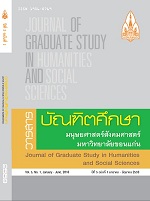การล่องหนบ่งความหมาย-เด็กชายล่องหนในบทละคร เรื่อง Dancing at Lughnasa โดย Brian Friel
Keywords:
ลูกนอกสมรส, คนนอก, การล่องหน, illegitimacy, misfit, invisibilityAbstract
ตัวละครเด็กชายล่องหนในบทละครเรื่อง Dancing at Lughnasa โดย Brian Friel นั้น ถือได้ว่าเป็นองค์ประกอบที่มีความโดดเด่นที่สุดองค์ประกอบหนึ่ง ของบทละครเรื่องนี้ และยังเป็นองค์ประกอบที่นำไปสู่การตีความอย่างหลากหลายด้วย และหนึ่งในวิธีการที่สามารถนำมาใช้ในการตีความตัวละครเด็กชายล่องหนนั้นก็คือ การมองเด็กชายล่องหนผ่านทางบริบทของการเป็นลูกนอกสมรส ซึ่งเป็นแก่นหลัก แก่นหนึ่งของบทละครเรื่องนี้ หากมองในบริบทแก่นเรื่องดังกล่าวนี้แล้ว เด็กชายล่องหน อาจสามารถตีความได้ว่าเป็นการแสดงออกถึงการไม่เป็นอันหนึ่งอันเดียวกันกับ ครอบครัวของตัวผู้บรรยายซึ่งเห็นได้จากหลายเหตุการณ์ในบทละคร จากวิธีการเล่า เรื่องจากความทรงจำของ Michael ซึ่งสอดแทรกไปด้วยความตระหนักรู้ถึงความไม่ เข้ากันระหว่างสถานะลูกนอกสมรสของเขาและครอบครัวคาทอลิก รวมไปถึงความ ตั้งใจที่จะไม่ให้นำตัวละครเด็กชายหรือก็คือตัวเขาในวัยเด็กเข้าไปยุ่งเกี่ยวกับครอบครัว ทำให้เห็นได้ชัดว่า ตัวตนในวัยเด็กของเขาที่ล่องหน ไม่ปรากฏแก่สายตาผู้ชมนั้น คือ สัญลักษณ์ที่สื่อความหมายถึงสถานะของการเป็นคนนอกครอบครัวของตัวเขาเอง ในบทละครเรื่อง Dancing at Lughnasa นี้ การล่องหนของตัวละครบนเวทีจึงไม่ใช่การ จำกัดความรู้ความเข้าใจในตัวละครตัวนั้นของผู้ชม แต่อาจกล่าวได้ว่าเป็นวิธีในการนำเสนอ ตัวละครที่มองไม่เห็นได้ด้วยตานี้อย่างชัดเจนและล้ำลึกมากกว่า
The Descriptive Invisibility: the Invisible Boy in Brian Friel’s Dancing at Lughnasa
The element of the invisible boy in Brian Friel’s Dancing at Lughnasa is notably recognized and thus, received several critical interpretations. One possible way to approach this invisibility is through the theme of illegitimacy which is one of the most prominent themes of the play. In the light of the theme, the invisible boy can be interpreted as the narrator’s expression of his lack of a sense of belonging to the family as supported by several textual evidences. From Michael’s narration of the story of his past which is infused with his traumatic awareness of the incompatibility between his illegitimacy and his Catholic family and his intention to disallow the boy from involving with the family, it becomes evident that his invisible younger self unseen by the audience might symbolize Michael’s recognition of himself as the family misfit. In Dancing at Lughnasa, the invisibility of the character on stage, thus, is not the limitation of the audience’s insight into the character, but it is the mean to give a more profound and vivid description of that absent character.






